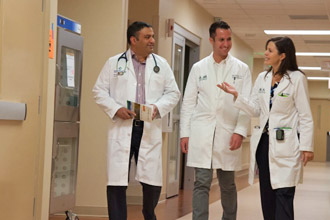SCL Health saw its lowest rate of falls in almost four years in September, thanks in large part to work from care sites across the system to share best practices with one another. The organization saw just 59 falls and 1.88 falls per 1,000 patient days across eight care sites in three states.
There’s still more work to be done. Even one fall is too many, quality leaders say, and not all targets are being met.
Even so, September reflects the progress as the organization leverages skill, scale and learning to achieve ministry excellence.
Leslie Kunz, RN, Director of Medical/Surgical Services at Good Samaritan Medical Center, attributes the success to the work of the multidisciplinary Falls Collaborative team composed of associates across all care sites. The group, originally formed in 2013 with a Leven Grant aimed at decreasing falls and falls with injury, examines, evaluates, trials and implements best practice strategies to achieve a sustainable reduction in preventable falls and resulting injuries. Leven Grants are grants that SCL Health’s Leven Foundation confers for safety projects.
Particularly valuable, Kunz said, is the sharing of best practices across the system and giving care sites ownership in correcting the challenges and holding them accountable for improvement.
“The focus has been on consistent best practices, which include a post-fall huddle; consistent messaging to our patients about ‘call, don’t fall’; and being with our fall-risk patients (in the bathroom),” she said. There is a high correlation between bathroom use and falls.
The group then shares best practices and challenges on a monthly basis. “Our units that are having the most challenges, we have them work on ways to decrease those falls and then present those to the Collaborative,” she said.

Note: Green arrow is the target, while the green line represents the mean fall rate. Process shifts are represented by shifts (up or down) of the mean and control limits (red dotted lines).
In November 2014, the Falls Collaborative set goals of a 20% reduction in both fall rate and falls with injury rate by the end of 2015. The system will not achieve either target by year’s end, said Chris Bliersbach, Senior Director of Clinical Outcomes for SCL Health. But metrics show steady movement in that direction.
Holy Rosary Healthcare, for example, met its 2015 targets for reducing falls and falls with injury, with a 24% reduction in fall rate and a 46% reduction in falls with injury rate. Saint Joseph Hospital met its falls with injury reduction target, reducing it 16 percent, and Saint Joseph Hospital’s fall rate continues to be the system’s lowest. Lutheran Medical Center’s fall rate is the second lowest in the system, and its 0.34 rate of falls with injury is the system’s best.
The Falls Collaborative in 2013 initially set a goal for 2014 of 33 percent reduction in falls that are classified as Hospital-Associated Conditions (HAC), and a 10 percent reduction in falls with injury. The team achieved an HAC fall reduction of 19 percent, but the fall rate per 1,000 patient days was reduced by 13 percent and the falls with injury rate was 30 percent – triple the 10 percent goal.
Bliersbach points to these milestones as also deserving of mention:
• Both Lutheran Medical Center and Saint Joseph Hospital fall rates are well below the National Database for Nursing Quality Indicators (NDNQI) 25th percentile;
• St. James Healthcare has reduced its fall rate by 15 percent year-to-date;
• St. Mary’s Medical Center reduced its fall with injury rate 13 percent;
• Good Samaritan Medical Center’s fall with injury rate has been below the historical average in six of the past seven months;
• St. Francis Health achieved its second lowest fall rate over the past year in October, and a low fall with injury rate;
• Since June 2015, when SCL Health instituted a targeted reduction effort on the Top 10 high volume units, there has been a 38 percent reduction in the average number of falls per month, from 42 to 26.
Platte Valley Medical Center was not included in the analysis, but will be offered the opportunity to join the Falls Collaborative in 2016.
Efforts to reduce falls with injury consist of a number of measures, Kunz said. Among them, care sites are looking at updating patients beds to have more of an indication whether a bed alarm is on or off and if the side rail is up or down; implementation of the hourly rounding bedside report initiative; and an assessment of patients prior to admission to determine fall risk.
“All of these interventions plus several others are going to be what it takes us to get to the next level of reducing falls with injury,” Kunz said. “Data shows that if the elderly have a fall with injury, their mortality is increased. Our mission is to do no harm – keep our patients safe.”



